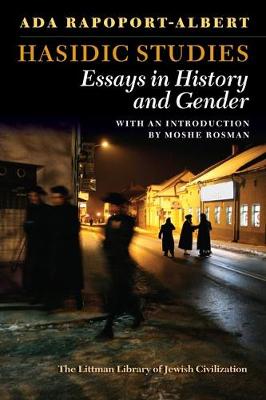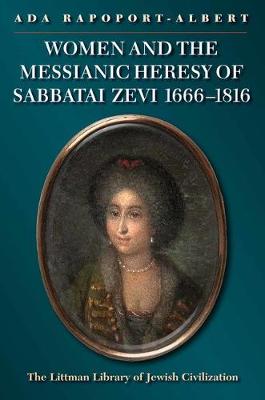The Littman Library of Jewish Civilization
2 total works
Ada Rapoport-Albert has been a key player in the profound transformation of the history of hasidism that has taken shape since the 1970s. She has never lacked the courage to question conventional wisdom, but neither has she overturned it lightly.
The essays in this volume show the erudition and creativity of her contribution to rewriting the master-narrative of hasidic history. Thanks to her we now know that eighteenth-century hasidism evolved in a context of intense spirituality rather than political, social, economic, or religious crisis. It did not represent the movement's 'classic period' and was not a project of democratization, ameliorating the hierarchical structuring of religion and spirituality. Eighteenth-century hasidism is more accurately described as the formative and creative prelude to the mature movement of the nineteenth century: initially neither institutionalized nor centralized, it developed through a process of differentiation from traditional ascetic-mystical hasidism. Its elite leaders only became conscious of a distinctive group identity after the Ba'al Shem Tov's death, and they subsequently spent the period from the late eighteenth to the early nineteenth century experimenting with various forms of doctrine, literature, organization, leadership, and transfer of authority.
Somewhat surprisingly there was no attempt to introduce any revision of women's status and role; in the examination of this area of hasidism Rapoport-Albert's contribution has been singularly revealing. Her work has emphasized that, contrary to hasidism's thrust towards spiritualization of the physical, the movement persisted in identifying women with an irredeemable materiality: women could never escape their inherent sexuality and attain the spiritual heights. Gender hierarchy therefore persisted and, formally speaking, for the first 150 years or so of hasidism's existence women were not counted as members of the group. Twentieth-century Habad hasidim responded to modernist feminism by re-evaluating the role of women, but just as Habad appropriated modern rhetorical strategies to defend tradition, so it adopted certain feminist postulates in order to create a counter-feminism that would empower women without destabilizing traditional gender roles.
The essays in this volume are a fitting statement of Professor Rapoport-Albert's importance to the study of hasidism, to Jewish studies as a whole, and to the academic scrutiny of religion. Written over a period of forty years, they have been updated for this volume with regard to significant detail and to take account of important works of scholarship written after they were originally published.
The essays in this volume show the erudition and creativity of her contribution to rewriting the master-narrative of hasidic history. Thanks to her we now know that eighteenth-century hasidism evolved in a context of intense spirituality rather than political, social, economic, or religious crisis. It did not represent the movement's 'classic period' and was not a project of democratization, ameliorating the hierarchical structuring of religion and spirituality. Eighteenth-century hasidism is more accurately described as the formative and creative prelude to the mature movement of the nineteenth century: initially neither institutionalized nor centralized, it developed through a process of differentiation from traditional ascetic-mystical hasidism. Its elite leaders only became conscious of a distinctive group identity after the Ba'al Shem Tov's death, and they subsequently spent the period from the late eighteenth to the early nineteenth century experimenting with various forms of doctrine, literature, organization, leadership, and transfer of authority.
Somewhat surprisingly there was no attempt to introduce any revision of women's status and role; in the examination of this area of hasidism Rapoport-Albert's contribution has been singularly revealing. Her work has emphasized that, contrary to hasidism's thrust towards spiritualization of the physical, the movement persisted in identifying women with an irredeemable materiality: women could never escape their inherent sexuality and attain the spiritual heights. Gender hierarchy therefore persisted and, formally speaking, for the first 150 years or so of hasidism's existence women were not counted as members of the group. Twentieth-century Habad hasidim responded to modernist feminism by re-evaluating the role of women, but just as Habad appropriated modern rhetorical strategies to defend tradition, so it adopted certain feminist postulates in order to create a counter-feminism that would empower women without destabilizing traditional gender roles.
The essays in this volume are a fitting statement of Professor Rapoport-Albert's importance to the study of hasidism, to Jewish studies as a whole, and to the academic scrutiny of religion. Written over a period of forty years, they have been updated for this volume with regard to significant detail and to take account of important works of scholarship written after they were originally published.
Women and the Messianic Heresy of Sabbatai Zevi, 1666 - 1816
by Ada Rapoport-Albert
Published 17 March 2011
Women are conspicuously absent from the Jewish mystical tradition. Even if historically some Jewish women may have experienced mystical revelations and led richly productive spiritual lives, the tradition does not preserve any record of their experiences or insights. Only the chance survival of scant evidence suggests that, at various times and places, individual Jewish women did pursue the path of mystical piety or prophetic spirituality, but it appears that they were generally censured, and efforts were made to suppress their activities. This contrasts sharply with the fully acknowledged prominence of women in the mystical traditions of both Christianity and Islam. It is against this background that the mystical messianic movement centred on the personality of Sabbatai Zevi (1626 - 76) stands out as a unique and remarkable exception. Sabbatai Zevi addressed to women a highly original liberationist message, proclaiming that he had come to make them 'as happy as men' by releasing them from the pangs of childbirth and the subjugation to their husbands that were ordained for women as a consequence of the primordial sin.
This unprecedented redemptive vision became an integral part of Sabbatian eschatology, which the messianists believed to be unfolding and experienced in the present. Their New Law, superseding the Old with the dawning of the messianic era, overturned the traditional halakhic norms that distinguished and regulated relations between the sexes. This was expressed not only in the outlandish ritual transgression of sexual prohibitions, in which Sabbatian women were notoriously implicated, but also in the apparent adoption of the idea - alien to rabbinic Judaism - that virginity, celibacy, or sexual abstinence were conducive to women's spiritual empowerment. Ada Rapoport-Albert traces the diverse manifestations of this vision in every phase of Sabbatianism and its offshoots. These include the early promotion of women to centre-stage as messianic prophetesses; their independent affiliation with the movement in their own right; their initiation in the esoteric teachings of the kabbalah; and their full incorporation, on a par with men, into the ritual and devotional life of the messianic community.
Their investment with authority was such as to elevate the messiah's wife (a figure mostly absent from traditional messianic speculations) to the rank of full messianic consort, sharing in her husband's redemptive mission as well as his divine dimension. By the late eighteenth century, a syncretistic cult had developed that recognized in Eva - the unmarried daughter of Jacob Frank, one of Sabbatai Zevi's apostate messianic successors - an incarnate female aspect of the kabbalistic godhead, worshipped by her father's devotees as 'Holy Virgin' and female messiah. This was the culmination of the Sabbatian endeavour to transcend the traditional gender paradigm that had excluded women from the public arena of Jewish spiritual life. This work is translated by Deborah Greniman.
This unprecedented redemptive vision became an integral part of Sabbatian eschatology, which the messianists believed to be unfolding and experienced in the present. Their New Law, superseding the Old with the dawning of the messianic era, overturned the traditional halakhic norms that distinguished and regulated relations between the sexes. This was expressed not only in the outlandish ritual transgression of sexual prohibitions, in which Sabbatian women were notoriously implicated, but also in the apparent adoption of the idea - alien to rabbinic Judaism - that virginity, celibacy, or sexual abstinence were conducive to women's spiritual empowerment. Ada Rapoport-Albert traces the diverse manifestations of this vision in every phase of Sabbatianism and its offshoots. These include the early promotion of women to centre-stage as messianic prophetesses; their independent affiliation with the movement in their own right; their initiation in the esoteric teachings of the kabbalah; and their full incorporation, on a par with men, into the ritual and devotional life of the messianic community.
Their investment with authority was such as to elevate the messiah's wife (a figure mostly absent from traditional messianic speculations) to the rank of full messianic consort, sharing in her husband's redemptive mission as well as his divine dimension. By the late eighteenth century, a syncretistic cult had developed that recognized in Eva - the unmarried daughter of Jacob Frank, one of Sabbatai Zevi's apostate messianic successors - an incarnate female aspect of the kabbalistic godhead, worshipped by her father's devotees as 'Holy Virgin' and female messiah. This was the culmination of the Sabbatian endeavour to transcend the traditional gender paradigm that had excluded women from the public arena of Jewish spiritual life. This work is translated by Deborah Greniman.

